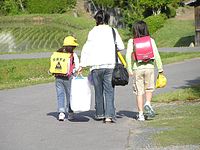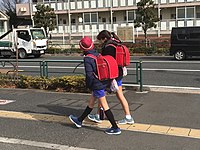Randoseru


Arandoseru(ランドセル)is a firm-sidedbackpackmade of stitched firmleatheror leather-like synthetic material, most commonly used inJapanbyelementaryschoolchildren. Traditionally it is given to a child upon beginning their first year of school, whereupon the child uses the same bag until grade 6. The term is borrowed from theDutchranselorGermanRanzenmeaning "backpack".[1][2][3]
A similar system is used in Western schools. However, compared to Japanese randoseru, such asSchulranzenfromGermanyandBoekentasfrom theNetherlands,many of them are simpler and lighter in material.
-
Two sisters wearing pink randoseru. One of them with a yellow plastic cover.
-
Two young girls with red randoseru, 2019.
-
Boy with black randoseru, 2018.
Design
[edit]In more conservative schools the color, brand and design is mandated, typically with red as the traditional color for girls and black for boys. More colorful versions such as pink, brown, dark blue, green, blue and even two-tones are also available.[4]These varieties have existed since the 1960s but sold poorly due to the lock-step mentality of the education system that gradually began changing in the early 2000s. The increased variety of colors is partly as a compromise for parents to retain some tradition within modernized schools which no longer require the use of traditional uniforms or therandoseru.[5]
A typicalrandoserumeasures roughly 30 cm high by 23 cm wide by 18 cm deep, and features a softer grade of leather or other material on those surfaces which touch the body. When empty, it weighs approximately 1.2 kilograms (2.6 pounds). However, due to demand for a lighter, more robustrandoseru,as of 2004 approximately 70% are made from the synthetic leatherClarino.[6]The backpacks have hard leather sides and divided compartments inside. They close with a long flap that goes over the entire length of the bag and clips at the bottom.[7]Manufacturers usually offer "randoseru" in two sizes, with a slightly larger one sized to hold modern A4 flat files.[8]
To increase traffic safety for children commuting to and from school, many communities have begun working with The Institute for Traffic Safety(An toàn giao thông hiệp hội,kōtsū anzen kyōkai)to distribute yellow plastic covers that drape over the back of therandoseruto increase its visibility.[9]
History
[edit]
The use of therandoserubegan in theEdoera. Along with a wave of western reforms in the Japanese military, the Netherlands-style rucksack called ransel(ランドセル,randoseru)was introduced as a new way for the foot soldiers to carry their baggage. The shape much resembled therandoserubags used today. In 1885, the Japanese government, through the elementary schoolGakushūin,proposed the use of a backpack as the new ideal for Japanese elementary school students. AtGakushūin,the practice of coming to school by cars and rickshaws were banned, promoting the idea that the students should carry their own equipment and come to school on foot. At this time, the bag looked more like a normal rucksack. This changed, however, in 1887. The crown prince of the time was given a backpack upon entering elementary school (at Gakushūin). To honor the soldiers of the country, the shape of the backpack resembled the backpacks used in the military. This quite immediately became the fashion, and the shape has continued to become therandoseruused today. However, at that time most of the Japanese people could not afford such an expensive bag. Until the dramatic rise of economy in Japan in the post-World War II period, the main school bags in Japan were simple shoulder bags andfuroshiki(square folding cloths).[10][11]
It is a popular saying that the metal clip on the side of therandoseruwas used in the military to carry grenades. However, this is not true. The metal clip was introduced in the post-World War II period, as a means to carry lunch boxes, change of clothes for P.E., etc.
Around March 2014, American actressZooey Deschaneltook her picture with a redrandoseruon her back.
In recent years, in addition to the boom spread by the above-mentioned American actress, there are an increasing number of people outside Japan who know aboutrandoseruthrough Japanese animation,manga,etc. and purchase them as souvenirs when traveling to Japan. They are sometimes sold in stores for tourists and in airports in Japan.
Production
[edit]Mostrandoseruproduction is carried out by hand. Arandoseruis constructed of a single-piece body and around 200 fittings, a combination of die-cut materials andpolyurethanebacking plates. Assembly involves crimping, machine-sewing, walnut-gluing, drilling each shoulder strap, and riveting.[4]The bag's materials and workmanship are designed to allow the backpack to endure the child's entire elementary education (six years). However, the care usually given to therandoseruthroughout that time and afterwards can extend its life and preserve it in near-immaculate condition long after the child has reached adulthood, a testament to its utility and the sentiment attached to it by many Japanese as symbolic of their relatively carefree childhood years.[12]
Therandoseru's durability and significance is reflected in its cost. A newrandoserumade ofgenuineorsyntheticleather can carry a price tag of around 30,000–40,000yenat a chain store/supermarket.[13]Typicallyrandoserufrom department stores or traditional workshops will be priced in the region of 55,000–70,000 yen, with some models (particularly those branded with logos) reaching over 100,000 yen.[14]Clarino,a synthetic material frequently used as a substitute,[12]reduces the cost somewhat. Oftenrandoseruare available on auction sites in new or used condition at much lower prices, particularly after the start of the Japanese school year in April. As of January 2012, the five toprandoseruin order of popularity atAmazon.co.jpare in the range of ¥8,280–16,980.[15]
See also
[edit]References
[edit]- ^"ランドセル - Weblio sách tra cứu".weblio.jp(in Japanese). GRAS Group.Retrieved21 August2021.
- ^"ランドセル の ý vị - goo quốc ngữ sách tra cứu".goo sách tra cứu(in Japanese). NTT Resonant Inc.Retrieved21 August2021.
- ^Rich, Motoko; Hayashi, Noriko (2024-07-15)."The Book Bag That Binds Japanese Society".The New York Times.ISSN0362-4331.Retrieved2024-07-16.
- ^ab"ニッポン・ロングセラー khảo Vol.11 ランドセル".Comzine(in Japanese). NTTコムウェア. 2004-03-24.Retrieved2010-12-14.
- ^Shimura, Gorō (2008).The Map of My Life.New York: Springer Science+Business Media. pp. 19–20.doi:10.1007/978-0-387-79715-1.ISBN978-0-38779714-4.OCLC254700435.Retrieved24 May2012.
There were naturally plenty of knapsacks in the store, and she asked me which one I liked. Somehow I was attracted to one in light brown that had a soft feel, and picked it.... On the first day of school I discovered that practically all new pupils had black, red, or pink ones
- ^"The Story of the Birth of New Products: CLARINO".Kuraya.Aiming to Achieve High Quality - picture with caption "School bag made with Clarino". 2006.Retrieved30 November2023.
- ^Ito, HanaSara (2020-04-13)."These Iconic Japanese Randoseru Backpacks Aren't Just For Kids Anymore".Live Japan.Retrieved2020-08-19.
- ^"ランドセル の 『A4クリアファイル đối ứng 』『A4フラットファイル đối ứng 』は, gì がどう vi う の?".Yamamoto Bag Workshop(in Japanese). January 1, 2016.RetrievedMarch 19,2019.
- ^YABAI Writers (2017-08-25)."The Japanese Randoseru, the Ultimate Schooler's Backpack".yabai.Retrieved2022-12-27.
- ^Kanno Akihiko - Koori Yoshiyuki (2020-01-31)."The future and past of Japanese randoseru".nhk.or.jp,NHK World-Japan.Retrieved2023-01-23.
- ^Cornelius Phanthanh (2020-02-01)."The Japanese backpack: facts and origins of the randoseru".gogonihon.Retrieved2023-01-23.
- ^abGordenker, Alice (20 March 2012)."Randoseru".So, What the Heck Is That?.The Japan Times(monthly column). p. 10.RetrievedMay 24,2012.
- ^"Randoseru report".RetrievedSeptember 17,2016.
- ^"Department store Randoseru section".Takashimaya.RetrievedSeptember 17,2016.
- ^Lucy Dayman (2019-01-01)."Randoseru: How to Choose the Best Japanese Backpack".japanobjcts.Retrieved2022-12-27.
External links
[edit]- Manufacturing process of a randoseru (1998)(movie) (Japanese)
- Video of randosel manufacture (2024)from Process X




